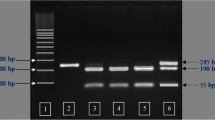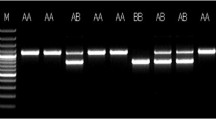Abstract
Genetic variation of insulin-like growth factor binding protein-3 was analyzed in 17 pig breeds (14 native Chinese and 3 European). Using PCR-single strand conformation polymorphism, we found a polymorphism in intron 2, and this SNP was the combined mutation of G897T-G903A-C911T. The Chinese breeds carried a higher TAT/TAT genotype frequency (over 50%), except for Bamei (22%), Yujiang Black (0.0%), and Erhualian (10.0%); the European breeds had a higher GGC/GGC genotype frequency (Large White 1.67%, Landrace 13.89%, Duroc 0.0%). The allelic frequency of TAT in Chinese breeds was over 50%, except for Yujiang Black (12.5%); the allelic frequency of GGC was over 50% in all European breeds. The effect of genotype on 43 performance traits was investigated in one population (Lantang × Landrace). Pigs with the TAT/TAT genotype had higher B-point and C-point back-fat thickness than pigs with the GGC/GGC genotype. The TAT/TAT pigs also scored higher in meat color than the GGC/GGC pigs. These results implied that IGFBP-3 may affect meat quality and carcass traits.

Similar content being viewed by others
References
Cogan JD, Phillips JA 3rd (1998) Growth disorders caused by genetic defects in the growth hormone pathway. Adv Pediatr 45:337–361
De Koning DJ, Harlizius B, Rattink AP, Groenen MAM, Brascamp EW, van Arendonk JAM (2001) Detection and characterization of quantitative trait loci for meat quality traits in pigs. J Anim Sci 79:2812–2819
Fontanesi L, Davoli R, Nanni Costa L, Scotti E, Russo V (2003) Study of candidate genes for glycolytic potential of porcine skeletal muscle: identification and analysis of mutations, linkage and physical mapping and association with meat quality traits in pigs. Cytogenet Genome Res 102:145–151
Fujii J, Otsu K, Zorzato F, de Leon S, Khanna VK, Weiler JE, O’Brien PJ, Maclennan DH (1991) Identification of a mutation in porcine ryanodine receptor associated with malignant hyperthermia. Science 253:448
Geldermann H, Müller E, Moser G, Reiner G, Bartenschlager H, Cepica S, Stratil A, Kuryl J, Moran C, Davoli R, Brunsch C (2003) Genome-wide linkage and QTL mapping in porcine F2 families generated from Pietrain, Meishan and Wild Boar crosses. J Anim Breed Genet 120:363–393
Gillard EF, Otsu K, Fujii J, Duff C, De Leon S, Khanna VK, Brittb A, Worton NG, Maclennan DH (1992) Polymorphisms and deduced amino acid substitutions in the coding sequence of the ryanodine receptor (RYR1) gene in individuals with malignant hyperthermia. Genomics 13:1247–1254
Lahbib-Mansais Y, Yerle M, Pinton P, Gellin J (1996) Chromosomal localization of homeobox genes and associated markers on porcine chromosomes 3, 5, 12, 15, 16, and 18: comparative mapping study with human and mouse. Mamm Genome 7:174–179
Lee CY, Lee HP, Jeong JH, Baik KH, Jin SK, Lee JH, Sohn SH (2002) Effects of restricted feeding, low-energy diet, and implantation of trenbolone acetate plus estradiol on growth, carcass traits, and circulating concentrations of insulin-like growth factor (IGF)-1 and IGF-binding protein-3 in finishing barrows. J Anim Sci 80:84–93
Lee CY, Chung YS, Kim JH (2003) Quantitative trait loci mapping for fatty acid contents in the backfat on porcine chromosomes 1, 13, and 18. Mol Cells 15:62–67
Li JQ (2002) QTL mapping and candidate gene analysis for pig important economic traits. Thesis for Doctor’s Degree, Huanan Agricultural University
Nielsen VH, Larsen NJ (1997) A DraI RFLP at the porcine insulin-like growth factor binding protein 3 (IGFBP3) gene. Anim Genet 28:152–153
Ongeri EM, Zhu Q, Verderame MF, Hammond JM (2004) Insulin-like growth factor-binding protein-3 in porcine ovarian granulosa cells: gene cloning, promoter mapping, and follicle-stimulating hormone regulation. Endocrinology 145:1776–1785
Owens PC, Gatford KL, Walton PE, Morley W, Campell RG (1999) The relationship between endogenous insulin-like growth factors and growth in pigs. J Anim Sci 77:2098–2103
Rajaram S, Baylink DJ, Mohan S (1997) Insulin-like growth factor-binding protein in serum and other biological fluids: regulation and functions. Endocr Rev 18:801–831
Samaras SE, Hagen DR, Shimasaki S, Ling N, Hammond JM (1992) Expression of insulin-like growth factor-binding protein-2 and -3 messenger ribonucleic acid in the porcine ovary: localization and physiological changes. Endocrinology 130:2739–2744
SAS (1989) SAS user’s guide. SAS Inst. Inc., Cary, NC
Stearns TM, Beever JE, Southey BR, Ellis M, McKeith FK, Rodriguez-Zas SL (2005) Evaluation of approaches to detect quantitative trait loci for growth, carcass, and meat quality on swine chromosomes 2, 6, 13, and 18. II. Multivariate and principal component analyses. J Anim Sci 83:2471–2481
Walton PE, Gopinath R, Etherton TD (1989) Porcine insulin-like growth factor (IGF) binding protein blocks IGF-I action on porcine adipose tissue. Proc Soc Exp Biol Med 190:315–319
Wu XL, Lee C, Jiang J, Peng YL, Yan HF, Yang SL, Xiao BN, Liu XC, Shi QS (2001) Mapping a quantitative trait locus for growth and backfat on porcine chromosome 18. Asian-Aust J Anim Sci 15:932–937
Wu XL, Lee C, Jiang J, Peng YL, Yan HF, Yang SL, Xiao BN, Liu XC, Shi QS (2002) Quantitative trait loci mapping for porcine backfat thickness. Asian-Aust J Anim Sci 15:932–937
Zapf JH, Schmid H, Froesch ER (1984) Biological and immunological properties of insulin-like factors (IGF) 1 and 2. Clin Endocrinol Metab 13:3–30
Acknowledgments
This work was supported by the State Key Basic Research and Development Program (G200000161) and the Doctoral Initiation Fund of Jiangxi Agricultural University (2004). The authors thank Prof. Chen Yaosheng, Huanan Agricultural University, Guangdong, China, for his kind donation of the Jinhua × Pietrain population family.
Author information
Authors and Affiliations
Corresponding author
Rights and permissions
About this article
Cite this article
Wang, W., Meng, Q., Hu, X. et al. Genetic Variation and Association of Insulin-Like Growth Factor Binding Protein-3 with Performance in Swine. Biochem Genet 47, 315–321 (2009). https://doi.org/10.1007/s10528-009-9230-x
Received:
Accepted:
Published:
Issue Date:
DOI: https://doi.org/10.1007/s10528-009-9230-x




